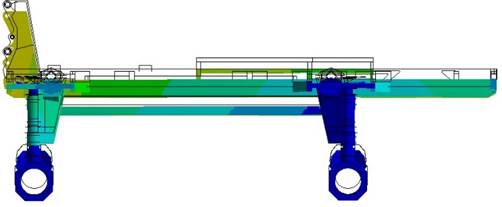Wilde Analysis helped PMC Harvesters improve the design and performance of the chassis of their new detasseling machine. Using FEA structural analysis, ANSYS software and technical knowledge from Wilde, design modifications were recommended to optimise the overall performance of the chassis and consequently the machine.
Company

PMC Harvesters Ltd has been manufacturing pea & bean harvesters in Fakenham, Norfolk since 1970. These machines are in use throughout the world. Recently, the company has developed a new machine for detasseling seed corn.
Background
The destasseling machine is used to remove the pollen producing flowers from the tops of corn plants using two sets of interchangeable tooling that are mounted on the front of the machine. One set of tooling provides a ‘cutting’ function, whereas the other set provides a ‘pulling’ function. The rest of the machine must pass through the crop with minimal damage.
Challenge
PMC Harvesters wanted to enhance the performance of the prototype detasseling machine by improving the design of the chassis. During use, this machine is subjected to many different loads and combinations, broadly separated into two categories: ‘Road going loads’ and ‘Field operational loads’. During this project, Wilde considered four load cases in each of these categories.
In order to provide the recommendations for a new chassis design, Wilde used ANSYS Mechanical structural mechanics software to closely analyse these 8 load cases each with accelerations of varying magnitudes in different directions to identify the stress contours.
The initial geometry provided by PMC Harvesters consisted of solid parts. In order to obtain a good balance between accuracy of results and solution time, a model with shell and beam elements was used for the analysis. This was achieved by mid-surfacing the original solid geometry.
Using ANSYS Mechanical software it was found that the majority of steel chassis experienced stress levels below the yield stress, however some areas were identified with stress levels above the yield stress.
These results enabled Wilde to recommend areas of improvement to the current design. This gave PMC Harvesters the confidence to proceed with building the chassis, incorporating Wilde’s recommendations. The process was completed with physical testing which validated the improved design.

Solution

The FEA analysis carried out by Wilde’s team along with their close working relationship with PMC Harvesters throughout the project improved the chassis design, therefore optimising the overall performance of the machine. The project met the required objectives and the new chassis are already being shipped around the world.
The results of the FEA analysis enabled Wilde to recommend areas of improvement to the current design. This gave PMC Harvesters the confidence to proceed with building the chassis, incorporating Wilde’s recommendations.
PMC Harvesters